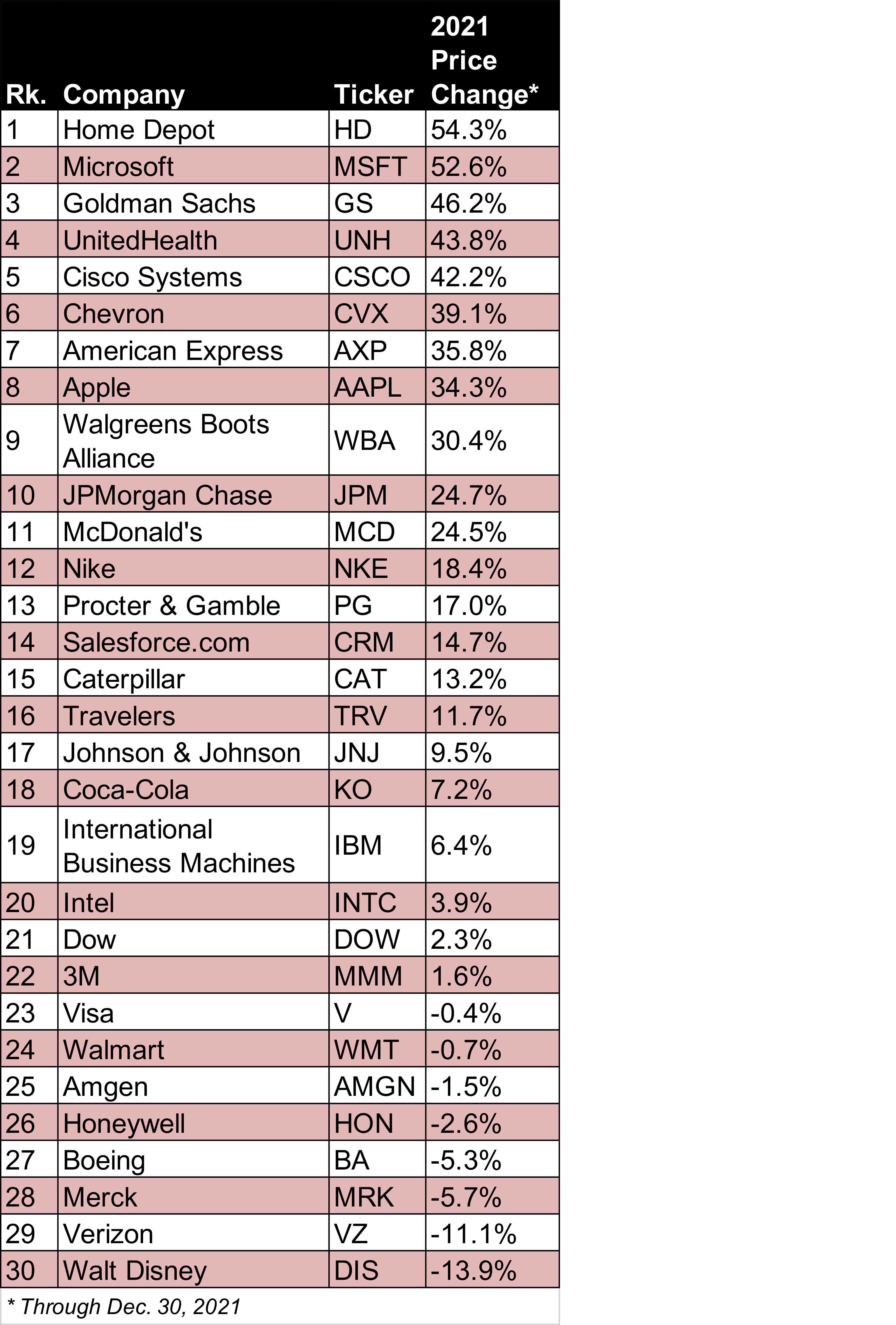The Best and Worst Dow Stocks of 2021
The Dow Jones Industrial Average produced well-above-average returns in 2021. But some of its venerable blue chips did far better ... while others left shareholders feeling shortchanged.


The Dow Jones Industrial Average shook off COVID-19, supply-chain snafus, inflationary pressures and myriad other worries to deliver an outstanding year in absolute terms. Indeed, the blue-chip bastion of Dow stocks generated a price gain of 19% through Dec. 30.
To get a sense of what an outlier 2021 was for the blue-chip average, the Dow's 30-year annualized price return comes to 8.7%.
Although the Dow as a whole powered through the pandemic, there's no question COVID-19 factored heavily in deciding the average's winners and losers in 2021, which we list in full down below. Naturally, the pandemic remains a key variable in the minds of Wall Street analysts as they rate the 30 Dow Jones stocks' prospects for 2022.

Sign up for Kiplinger’s Free E-Newsletters
Profit and prosper with the best of expert advice on investing, taxes, retirement, personal finance and more - straight to your e-mail.
Profit and prosper with the best of expert advice - straight to your e-mail.
Either way, many of this year's best Dow stocks are expected to continue their market-beating ways in the new year.
Take Home Depot (HD, $409.94) and Microsoft (MSFT, $339.32), for example. The Dow's top stocks of 2021 – each up by more than half – are forecast to put up more big gains in the year ahead thanks to a continuation of current trends.
In HD's case, the pandemic led to changes in consumer consumption patterns. Folks stuck at home decided to feather their nests, embrace do-it-yourself (DIY) projects and invest newfound discretionary income into their dwellings. The red-hot housing market also remains a tailwind at HD's back.
MSFT, meanwhile, has become a king of cloud-based services. The rise of remote work accelerated companies' embrace of Microsoft products such as Azure and Office 365. Looking ahead, analysts say enterprise customers are still in the early innings of their digital transformations.
On the other side of the ledger, analysts say some of this year's losers are set to become 2022's winners. Look no farther than Walt Disney (DIS, $155.93) for an example.
Disney was the Dow's worst stock in 2021, losing almost 14%. The media and entertainment conglomerate was essentially undone by the emergence of the Delta and Omicron variants of COVID-19. Anything that creates uncertainty around the health of Disney's all-important theme parks and resorts – not to mention its filmed entertainment business – is bad for DIS shareholders.
As much of a bummer as 2021 was for DIS, the Street gives shares a consensus recommendation of Buy, with fairly high conviction to boot. The pandemic can't last forever, the thinking goes, and shares look cheap.
Here's hoping, anyway.
Without further ado, have a look at how all 30 Dow stocks fared in 2021 in the table below:

Get Kiplinger Today newsletter — free
Profit and prosper with the best of Kiplinger's advice on investing, taxes, retirement, personal finance and much more. Delivered daily. Enter your email in the box and click Sign Me Up.

Dan Burrows is Kiplinger's senior investing writer, having joined the august publication full time in 2016.
A long-time financial journalist, Dan is a veteran of MarketWatch, CBS MoneyWatch, SmartMoney, InvestorPlace, DailyFinance and other tier 1 national publications. He has written for The Wall Street Journal, Bloomberg and Consumer Reports and his stories have appeared in the New York Daily News, the San Jose Mercury News and Investor's Business Daily, among many other outlets. As a senior writer at AOL's DailyFinance, Dan reported market news from the floor of the New York Stock Exchange.
Once upon a time – before his days as a financial reporter and assistant financial editor at legendary fashion trade paper Women's Wear Daily – Dan worked for Spy magazine, scribbled away at Time Inc. and contributed to Maxim magazine back when lad mags were a thing. He's also written for Esquire magazine's Dubious Achievements Awards.
In his current role at Kiplinger, Dan writes about markets and macroeconomics.
Dan holds a bachelor's degree from Oberlin College and a master's degree from Columbia University.
Disclosure: Dan does not trade individual stocks or securities. He is eternally long the U.S equity market, primarily through tax-advantaged accounts.
-
 How to Protect Your Privacy While Using AI
How to Protect Your Privacy While Using AIHow to keep your information and finances safe while using AI, including ChatGPT and Perplexity.
By Bob Haegele
-
 Most of the Money in IRAs Comes from a Surprising Source
Most of the Money in IRAs Comes from a Surprising SourceAmericans don't typically stash money in IRAs from contributions. Here's how most people fund their IRAs, according to a new study.
By Christy Bieber
-
 Stock Market Today: Stocks Struggle Amid Tariff Uncertainty
Stock Market Today: Stocks Struggle Amid Tariff UncertaintyBoeing dropped after China suspended new aircraft orders, while Bank of America and Citi climbed on earnings beats.
By Karee Venema
-
 Stock Market Today: Stocks Gain on Tech, Auto Tariff Talk
Stock Market Today: Stocks Gain on Tech, Auto Tariff TalkThe Trump administration said late Friday that it will temporarily halt tariffs on some Chinese tech imports.
By Karee Venema
-
 Stock Market Today: Stocks Surge to Close a Volatile Week
Stock Market Today: Stocks Surge to Close a Volatile WeekIt was another day with a week's worth of both news and price action, but it ended on a strongly positive note.
By David Dittman
-
 Which Stocks Stayed Green as the Market Plummeted?
Which Stocks Stayed Green as the Market Plummeted?Only a handful of S&P 500 stocks managed to generate gains during the market's historic four-day plunge.
By Dan Burrows
-
 Stock Market Today: Uncertainty Proliferates: Dow Loses 1,014 Points
Stock Market Today: Uncertainty Proliferates: Dow Loses 1,014 PointsWeaker-than-expected consumer inflation data wasn't enough to stabilize sentiment during another volatile day for financial markets.
By David Dittman
-
 Stock Market Today: Tariff Pause Triggers 3,000-Point Dow Rally
Stock Market Today: Tariff Pause Triggers 3,000-Point Dow RallyThe bond market is sending concerning signals as the Trump administration executes its rapid reordering of global trade relationships.
By David Dittman
-
 Stock Market Today: Tariff Talks Drive Another Up-and-Down Day
Stock Market Today: Tariff Talks Drive Another Up-and-Down DayTrade war negotiations are happening, but the "fear gauge" is gyrating, and investors, traders and speculators are still searching for signs of a bottom.
By David Dittman
-
 Stock Market Today: Trump Pushes Dow Into 2,600-Point Swing
Stock Market Today: Trump Pushes Dow Into 2,600-Point SwingTariffs and trade war weigh on prices across global financial markets, with little light at the end of the tunnel.
By David Dittman